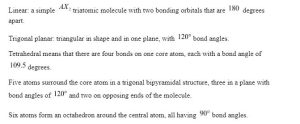Introduction
Valence bond theory:
The theory of valence bonds (VB) is a simple extension of Lewis structures. According to the valence bond theory, electrons in a covalent bond live in a region where individual atomic orbitals overlap. In molecular hydrogen, for example, the covalent bond is formed by the overlap of two hydrogen orbitals.
The VSEPR theory predicts the arrangement of electron pairs around each central atom, as well as the right arrangement of atoms in a molecule, in most cases. However, we must keep in mind that the theory solely addresses electron-pair repulsions. Other interactions, such as nuclear-nuclear repulsions and nuclear-electron attractions, are also important in determining the ultimate arrangement of atoms in a molecule structure.
By defining an order of repulsive force and an order of the space occupied by different sorts of electron pairs, VSEPR theory suggests these distortions.
The following is a list of electron-pair repulsions in order of highest to least repulsion:
The electron-pair geometry is the geometry that incorporates all electron pairs. The molecular structure is the structure that solely comprises the location of the atoms in the molecule. When there are no lone electron pairs around the centre atom, the electron-pair geometries will be the same as the molecular structures, but when there are lone pairs on the central atom, they will be different.
Molecular structures and electron pair geometry:
Angles between electron groups surrounding an atom that follows the octet rule are exactly 180° for two groups, but only close to for three or four groups unless they are all the same. Differences in the size of the bound atoms (large atoms tend to move apart to avoid ‘bumping’ one another) and differences in the interactions of lone pairs and bonding pairs (lone pairs are more diffuse than lone pairs, so they are larger and other electron regions tend to move away from them) can cause deviations from the predicted angles. The bond angle is the angle generated by two bonds intersecting.
Tetrahedral geometry of methane
The observed structures are based on the tetrahedron if the(steric number). The positions of the bound atoms lie at the corners of a tetrahedron when all four electron domains bond (then there are four atoms attached to the central atom). This geometry’s optimal bond angles are.
Methane’s bond angles are 109.5°, which is the angle formed by any two bonds. When four atoms of the same type are bound to the central carbon atom, the ideal tetrahedral angle is maintained.

But, when one of the bonding electron pairs is replaced with a nonbonding lone pair, the bond angles for the remaining bonds tend to fall from the ideal value. The reasoning behind this is that the lone pair’s negative charge is more widely distributed in space, which repels the bonding pairs (which are more confined, being constrained to the region between the two bound atoms), causing them to move closer together in space.
Geometry and polarity:
When the geometry of a molecule is known, its polarity can also be predicted.
The following are the most essential factors:
- The symmetry of the structure (or lack of it).
- A bond dipole is formed when the electronegativity of the linked atoms differs. The presence or absence of a strong bond dipole in a structure must be determined.
- To forecast the net dipole moment of the molecule, treat the bond dipoles as vectors and learn to sum the bond dipole vectors. Because of the symmetry of the molecule, the bond dipoles frequently cancel.
Conclusion
Chemical bonding is the attractive force that holds various constituents (atoms, ions, etc.) together and stabilises them by causing them to lose energy. As a result, the stability of chemical compounds is determined by the strength of chemical bonds between constituents; the stronger the bonding between constituents, the more stable the final complex is.
 Profile
Profile Settings
Settings Refer your friends
Refer your friends Sign out
Sign out














